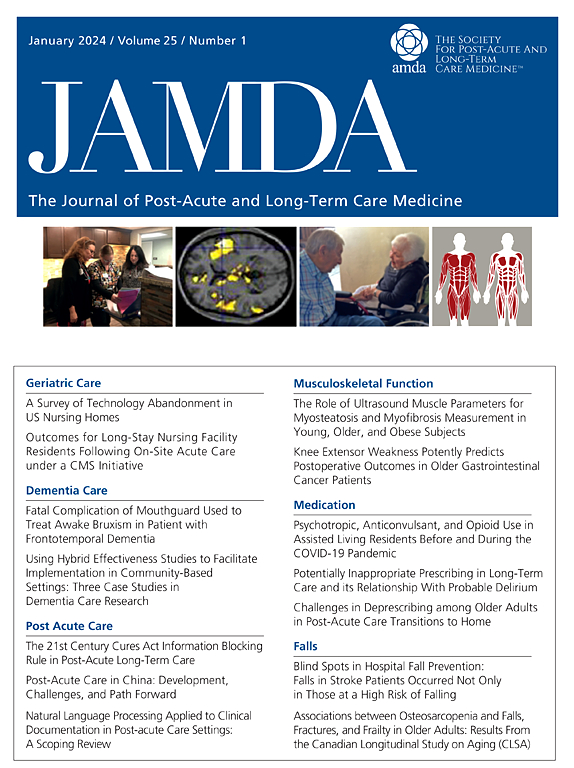纽约大都会区消费者导向的个人护理:2017年至2022年的使用趋势。
IF 4.2
2区 医学
Q2 GERIATRICS & GERONTOLOGY
Journal of the American Medical Directors Association
Pub Date : 2025-03-17
DOI:10.1016/j.jamda.2025.105535
引用次数: 0
摘要
目标:尽管人们对消费者(或自我)指导的医疗补助资助的个人护理模式的扩展越来越感兴趣,但研究项目使用的特征是有限的。我们利用来自纽约一个大型健康计划的健康计划和索赔数据来研究(1)消费者导向医疗使用的趋势和(2)COVID-19大流行对消费者导向医疗使用的影响。设计:回顾性队列研究。环境和参与者:所有在2017年1月至2022年12月期间参加大型纽约健康计划并接受医疗补助资助的个人护理的个人(n = 47,216)。方法:计算所有参保人以及新参保人和现有参保人亚组每月和每年接受消费者导向医疗的参保人比例。估计了一个中断时间序列模型,以检查时间趋势和COVID-19大流行发病对趋势的影响。结果:2017年至2022年间,接受消费者导向医疗的参保人比例从10.3%上升到47.9%。社会人口学特征和平均个人护理时间保持稳定。模型发现,在大流行前,使用消费者导向护理的参保者比例每年增加6% (P < 0.001),在2020年3月COVID-19大流行开始时,使用率立即增加了4% (P = 0.001),大流行开始后,使用率每年增加8% (P = 0.01)。尽管现有参保人的趋势反映了总体趋势,但新参保人在研究初期的消费者导向医疗使用方面有更大的增长,在2020年3月之后趋于平稳。结论和影响:虽然在2019冠状病毒病大流行开始时,接受消费者导向医疗服务的参保人数比例出现了统计学上显著的持续增长,但与2017年至2022年的总体项目增长相比,这一增长幅度很小。需要做更多的工作来了解其他因素如何影响投保人选择以消费者为导向的护理,以确保所有医疗补助资助的个人护理接受者都能在社区中满足他们的需求。本文章由计算机程序翻译,如有差异,请以英文原文为准。
Consumer-Directed Personal Care in the New York Metropolitan Area: Trends in Use From 2017 to 2022
Objectives
Despite growing interest in expansion of consumer- (or self-) directed models of Medicaid-funded personal care, research characterizing program use is limited. We leverage health plan and claims data from a large health plan in New York to examine (1) trends in use of consumer-directed care and (2) the impact of the COVID-19 pandemic on consumer-directed care use.
Design
Retrospective cohort study.
Setting and Participants
All individuals enrolled in a large, New York health plan who received Medicaid-funded personal care between January 2017 and December 2022 (n = 47,216).
Methods
Proportion of enrollees receiving consumer-directed care during each month and year was calculated for all enrollees and the subgroups of new and existing enrollees. An interrupted time series model was estimated to examine time trends and impact of the COVID-19 pandemic onset on trends.
Results
Between 2017 and 2022, the proportion of enrollees receiving consumer-directed care increased from 10.3% to 47.9%. Sociodemographic characteristics and average personal care hours remained stable. Models identified a 6% yearly increase in the proportion of enrollees using consumer-directed care pre-pandemic, (P < .001) an immediate 4% bump in use in March 2020 at the onset of the COVID-19 pandemic (P = .001), and an 8% yearly increase in use post pandemic onset (P = .01). Although trends among existing enrollees mirrored overall trends, new enrollees had larger increases in consumer-directed care use early in the study period, which leveled off after March 2020.
Conclusions and Implications
While there was a statistically significant and sustained increase in the proportion of enrollees receiving consumer-directed care at onset of the COVID-19 pandemic, the magnitude of this increase was small in comparison with overall program growth between 2017 and 2022. Additional work to understand how other factors contribute to enrollees choosing consumer-directed care is needed to ensure all Medicaid-funded personal care recipients can have their needs met in the community.
求助全文
通过发布文献求助,成功后即可免费获取论文全文。
去求助
来源期刊
CiteScore
11.10
自引率
6.60%
发文量
472
审稿时长
44 days
期刊介绍:
JAMDA, the official journal of AMDA - The Society for Post-Acute and Long-Term Care Medicine, is a leading peer-reviewed publication that offers practical information and research geared towards healthcare professionals in the post-acute and long-term care fields. It is also a valuable resource for policy-makers, organizational leaders, educators, and advocates.
The journal provides essential information for various healthcare professionals such as medical directors, attending physicians, nurses, consultant pharmacists, geriatric psychiatrists, nurse practitioners, physician assistants, physical and occupational therapists, social workers, and others involved in providing, overseeing, and promoting quality

 求助内容:
求助内容: 应助结果提醒方式:
应助结果提醒方式:


